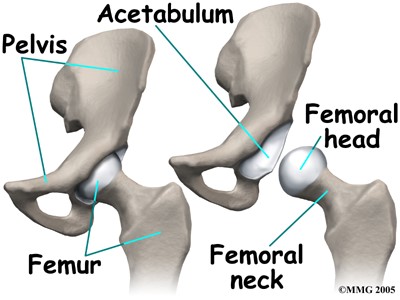Have you ever felt stiffness in the hips when you go to stand from a seated position, walk, or do any other types of movement? If so, there’s a very good chance that there is a problem with the mobility of the hip joints. By these, I mean the joints that connect the femur bone to the pelvis. This distinction is important because many times people refer to their SI joint, which is located above each buttock, as the hip. While the SI joint has its own potential for problems, this blog will be focused on the former.
 The hip joint is classified as a “ball and socket joint”, mainly due to its shape. The head of the femur bone is rounded and fits nicely into the bowl-shaped part of the pelvis known as the acetabulum. A ball-in-socket joint is one of the most freely movable joints, as it is not structurally limited in the various planes of motion. In other words, the joint is capable of moving in any direction. In order to accomplish these movements, muscles need to be present. With over 15 muscles surrounding, supporting and moving this hip joint, it is clear to see why it is capable of such motion.
The hip joint is classified as a “ball and socket joint”, mainly due to its shape. The head of the femur bone is rounded and fits nicely into the bowl-shaped part of the pelvis known as the acetabulum. A ball-in-socket joint is one of the most freely movable joints, as it is not structurally limited in the various planes of motion. In other words, the joint is capable of moving in any direction. In order to accomplish these movements, muscles need to be present. With over 15 muscles surrounding, supporting and moving this hip joint, it is clear to see why it is capable of such motion.
Conversely, it is also easy to see how abnormal muscle tension can affect the movement of this joint as well. If there are tight hamstrings or hip flexors, for example, the full range of motion of this joint cannot be accomplished. This can place additional stress on structures such as the low back. In order for the body to function optimally, muscle balance must be achieved and maintained.
In the office, there are a few ways in which we seek to improve hip mobility and achieve muscle balance.
1 – CHIROPRACTIC
From a chiropractic standpoint, adjusting the hip is a great way to free up any restrictions in the joint itself, allowing for proper joint spacing that bones need to be able to move fully and freely. By applying the same concepts to the hip as we do to the joints of the spine, chiropractors can help ease some of the pain and dysfunction seen at this joint.
2 – ACTIVE STRETCHING
 Additionally, active stretching methods such as Post-Isometric Relaxation (PIR) can help stretch any tight muscles in the surrounding areas. The hamstrings and hip flexors are common areas that are very tight, so it is important to make sure these muscles are looser if the hip is to be able to move better.
Additionally, active stretching methods such as Post-Isometric Relaxation (PIR) can help stretch any tight muscles in the surrounding areas. The hamstrings and hip flexors are common areas that are very tight, so it is important to make sure these muscles are looser if the hip is to be able to move better.
3- CORRECTIVE EXERCISE
Finally, corrective exercise is another great way to improve hip stability and mobility. Strengthening certain muscle groups such as the gluteal muscles in the buttock region is one way in which we can achieve the correct balance between strength and flexibility in areas such as the hip joint.
In order to achieve the best results, work outside the office in the form of corrective exercise and stretching must be continued. This is the best way to ensure you will get the most out of the work put in towards improving hip mobility. Hip joints are one of the most common joints that are replaced surgically, but there are other, more conservative methods for increasing range of motion and decreasing pain! Contact the Springfield Wellness Center at 217-726-0422 to learn more.
-Dr. Pat
